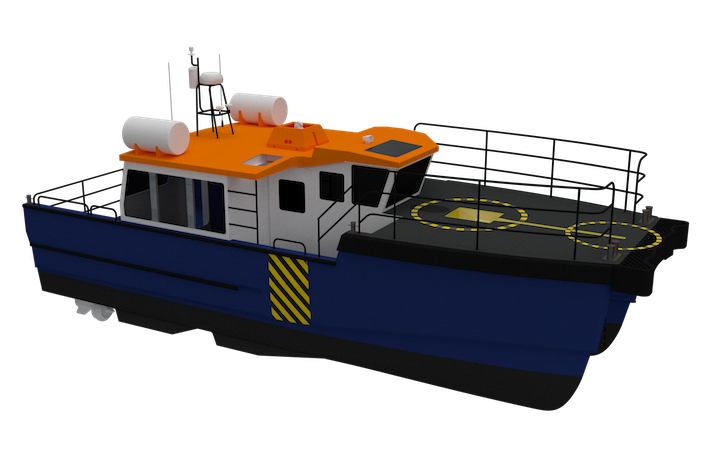Edison Chouest Offshore (ECO), Cut Off, La., announced recently that construction of the U.S. offshore wind industry’s first ever mini-crew transfer vessel (CTV) had begun.
The 39'x13.4'x7.4' mini-CTV, designed by Chartwell Marine, a UK-based naval architecture and marine engineering firm involved in next-generation vessel design, should be in operation in summer 2024.
The vessel will work for Ørsted and their U.S.-based joint venture partner, Eversource Energy. The aluminum mini-CTV will simultaneously accompany the launch of ECO Edison, the first ever U.S.-built service operation vessel (SOV), Chartwell officials said.
The “daughter craft” onboard the SOV can be deployed to efficiently maneuver crew across the Revolution Wind, South Fork Wind, and Sunrise Wind offshore wind farms in the U.S., under development by the joint venture.
“This vessel is the small but essential chain connecting SOVs and turbines together,” Andy Page, Chartwell’s managing director, said in a statement announcing the beginning of construction. “Engineers need to safely transition from larger vessels to turbines quickly and safely, and we set out to design an agile and streamlined vessel that has both bases covered.”
Page said the mini-CTV, which has a 3.6' draft and four tonnes of bollard pull, is not a one-size-fits-all. Turbines come in different configurations, with different requirements for effective crew transfer. That’s why he said Chartwell and ECO collaborated with Ørsted to thoroughly test and tweak the design to the joint venture portfolio’s particular needs. “We’re grateful for their collaboration and honored to have our design be the first out on U.S. waters servicing the renewables industry," he said.
Construction began in July at one of Edison Chouest’s Louisiana shipyards, employing an estimated 15 workers while drawing components from U.S. suppliers in five states. ECO will manage the entire pipeline of construction and operation, supported by the incentives provided by the Inflation Reduction Act.
“ECO Edison needed to have the perfect partner on launch, and Chartwell has crafted her,” Michael Braid, ECO’s vice president of renewables, said. “As we look to further expand our fleet and activate it across a growing number of offshore wind projects, maintaining the efficiency of our transfers and our high level of technical availability will be key. Diversifying the range of vessels we use is one of the ways we can achieve that, but making sure they’re best-in-class is equally important.”
Chartwell said its design meets the increasing demand in the U.S. offshore wind market for low-emissions, cost-effective support vessels, with the catamaran’s optimized hull form offering efficient fuel use as well as stability and maneuverability in choppy waters.
A first for this vessel type, main propulsion will come from a Volvo Penta IPS (integrated propulsion system) 500 system that is designed to provide high power and performance as well as onboard comfort for operators. The system allows for a wide number of optional features and functions, featuring forward-facing, twin counter-rotating propellers with an individually steerable IPS under the hull. The propulsion system will create a running speed of 20 knots.
The mini-CTV can carry a crew of up to 12 personnel and is designed to be conveniently deployed from ECO Edison during extended offshore stays, offering key staff efficient access to turbines, vessels, and other critical project infrastructure.
Working with Ørsted throughout the design process, Chartwell conducted model testing in January to simulate and adapt to the specifications of the wind turbines that will be installed at U.S. East Coast project sites.
Considerations were made to facilitate Ørsted’s "Get Up Safe" system, which is a motion-compensated hoist solution that enables technicians to safely transfer between small moving vessels and offshore wind turbines without a ladder.
“These vessels represent the incredible power of offshore wind to create American jobs in the industries of the future, deliver clean, renewable energy, and establish a U.S.-based supply chain that will benefit workers and communities for generations yet to come,” Mike Ausere, Eversource Energy’s vice president of business development, said.
The new mini-CTV will be USCG certified, Subchapter L.




